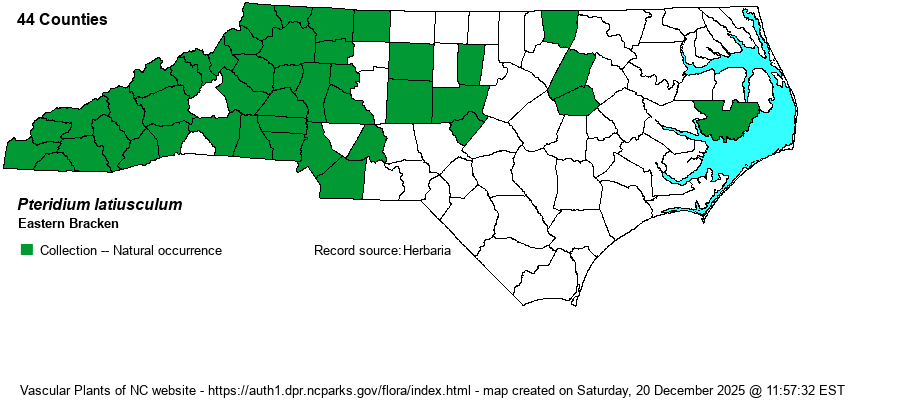| Author | (Desvaux) Hieronymus | |
| Distribution | The long-used name Pteridium aquilinum has been split in recent years, with that name reserved for Eurasian, African, etc. plants. North American plants are now P. latiusculum and P. pseudocaudatum. Weakley (2018) shows that the former occurs mostly in the Mountains and Piedmont, while the latter occurs mainly in the Piedmont and Coastal Plain. Although a few herbaria do seem to have re-examined at least some of their specimens, and the SERNEC database contains a handful of specimens labeled as P. latiusculum, the editors believe that mapping such incomplete data would be misleading at the present time. However, in January 2024 Sorrie extracted the distribution data from specimens at NCU. The specimen from Hyde County (Radford 33656 NCU) is densely pubescent, but the specimen from Wilson County (Radford 33270 NCU) is equivocal.
This is a Northeastern species, ranging from eastern Canada south to NC and TN, rarely to western FL and TX. | |
| Abundance | Common and widespread in the Mountains and Piedmont, but rare in the Coastal Plain. | |
| Habitat | This species grows in dry, acidic places, such as in upland woods (often where xeric), wooded borders, powerline clearings, old field, and many other dry places. The Hyde specimen is from "alluvial woods." |
| Phenology | Fruits from July to September. | |
| Identification | The two combined species are very similar. Collectively, the group has a widely triangular blade, about as wide as long, about 2-3 feet tall, at times to 4 feet tall, of which the petiole accounts for 6-10 inches. The blade is bipinnate-pinnatifid to tri-pinnate, with the ultimate pinnules being lanceolate and entire in shape. The blade tends to be rather thick and with a shiny upper surface. The sori are linear and continuous, along the margins of the pinnules on the blade underside. Weakley (2018) indicates that P. latiusculum has "Leaf segment margins slightly to moderately pubescent (with 1-12 hairs per mm); terminal (caudate) tip of the basalmost pinnule of the basal pinna (3-) avg. 12 (-28)% as long as the entire pinnule; terminal segments of well-developed pinnules generally 2-4x as long as broad, about 3-8 mm wide" -- versus P. pseudocaudatum having "Leaf segment margins glabrous (rarely sparsely pilose with as many as 4 hairs per mm); terminal (caudate) tip of the basalmost pinnule of the basal pinna (16-) avg. 25 (-45)% as long as the entire pinnule; terminal segments of well-developed pinnules generally 6-15x as long as broad, about 2-5 mm wide." As a result, P. latiusculum has leaves with wider ultimate pinnules (thumb-like) and the terminal ends (lobes) of the pinnules are rather short; P. pseudocaudatum has more narrowly cut ultimate pinnules (finger-like), and a distinctly long terminal tip to pinnules. | |
| Taxonomic Comments | See above.
| |
| Other Common Name(s) | Eastern Bracken Fern. Of course, Bracken or Bracken Fern applies to the combined two taxa/species. | |
| State Rank | S5 | |
| Global Rank | G5T5 [G5] | |
| State Status | | |
| US Status | | |
| USACE-agcp | | |
| USACE-emp | | |

